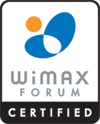
Interference
A variety of powerful tools are available in the PacketMAX® product to combat the effects of co-channel interference. The objective of this section is to provide brief descriptions of several of these techniques, which have been broadly classified into two categories:
- Interference Reduction Techniques: These techniques seek to reduce the amount of co-channel interference inflicted by a base station or SU on neighboring cells or sectors. Most of these techniques work through algorithms implemented at the transmitting end of the link.
- Interference Mitigation Techniques: These techniques seek to recover from the effects co-channel interference in case the interference reduction techniques have not been effective enough. Most but not all of these techniques work through algorithms implemented at the receiving end of the link.
Interference Reduction Techniques
Power Control: When transmissions occurs between the base station and a SU (or vice versa), then the resulting power from that signal leaks into neighboring cells and sectors and is directly responsible for all occurrences of co-channel interference. In order to reduce the amount of signal going into neighboring cells, the most straightforward policy is to transmit with lower power. However this conflicts with the requirement that in order to receive a signal reliably, the SINR (Signal to Noise + Interference Ratio), defined by SINR = Received Signal Power/(Noise Power + Interference Power), needs to be greater than a well defined threshold. Hence the optimal policy followed by the Aperto system, is to transmit with just enough power so that the SINR at the receiver is maintained above the threshold. In addition, all transmissions are made strictly in response to the availability of data to transmit, and at other times the transmitter is turned off. This helps in reducing the amount of power radiated, and thus co-channel interference.
Polarization Diversity: The base station or SU antennae in the Aperto system can be configured to transmit or receive using either horizontal or vertical polarization. Polarization can be used as a tool to reduce co-channel interference due to a property of polarized transmissions known as Cross Polarization Discrimination or XPD. Due to XPD, when a horizontally polarized antenna receives a co-channel signal sent from a vertically polarized antenna (and vice versa), the effective signal strength is reduced by several dB.
Cell Frequency Planning: The basic idea is to avoid using the same channels in neighboring cells, and leave sufficient distance between such cells, such that the resulting the SINR is above the threshold required for reliable reception. Aperto's use of smaller channel widths makes a large number of channels available to the operator, which can then be used for Frequency Planning purposes. Some competing products use up the entire available spectrum in a single cell, and are forced to re-use the same channels in neighboring cells, thus increasing the co-channel interference.
Interference Mitigation Techniques
ARQ - Re-Transmissions: Automatic Repeat request or ARQ is a re-transmission protocol that can be implemented at the link layer of a wireless system in order to recover from packet errors. When a packet is lost due to co-channel interference, then the receiver sends a NACK back to the transmitter. In response, the transmitter then attempts to re-transmit the errored packet at a later time. ARQ is most effective to recover from low to moderate error rates. When the interference is strong enough to cause high error rates, then the use of ARQ alone can cause a severe decrease in the available bandwidth. In such cases the system should couple ARQ with other techniques such as Adaptive Coding and Modulation to effectively combat interference.
Adaptive Coding and Modulation: Adaptive Coding and Modulation is defined as the ability of a base station to choose the right level of coding and modulation, for all transmissions to or from a SU. By using this feature, the base station is able to simultaneously support a set of SUs, each of which may have different modulation and coding levels. As pointed out in the previous section, the use of ARQ to combat co-channel interference breaks down when the packet error rates exceed a certain threshold. In this situation the system should reduce the modulation and/or coding level to that SU, which has the effect of decreasing the SINR threshold required for good reception, and thus restoring good link conditions. Aperto's adaptive coding and modulation is able to adapt in both directions, so that if the co-channel interference goes down and the link quality improves, then the modulation level increases.
Dynamic Frequency Selection: Dynamic Frequency Selection is a useful technique against co-channel interference, if more than one channel is available in each sector. The operator enters the available channels into the BSU, and the decision to change channels is made after other remedies, such as adaptive modulation or ARQ fail to work.


